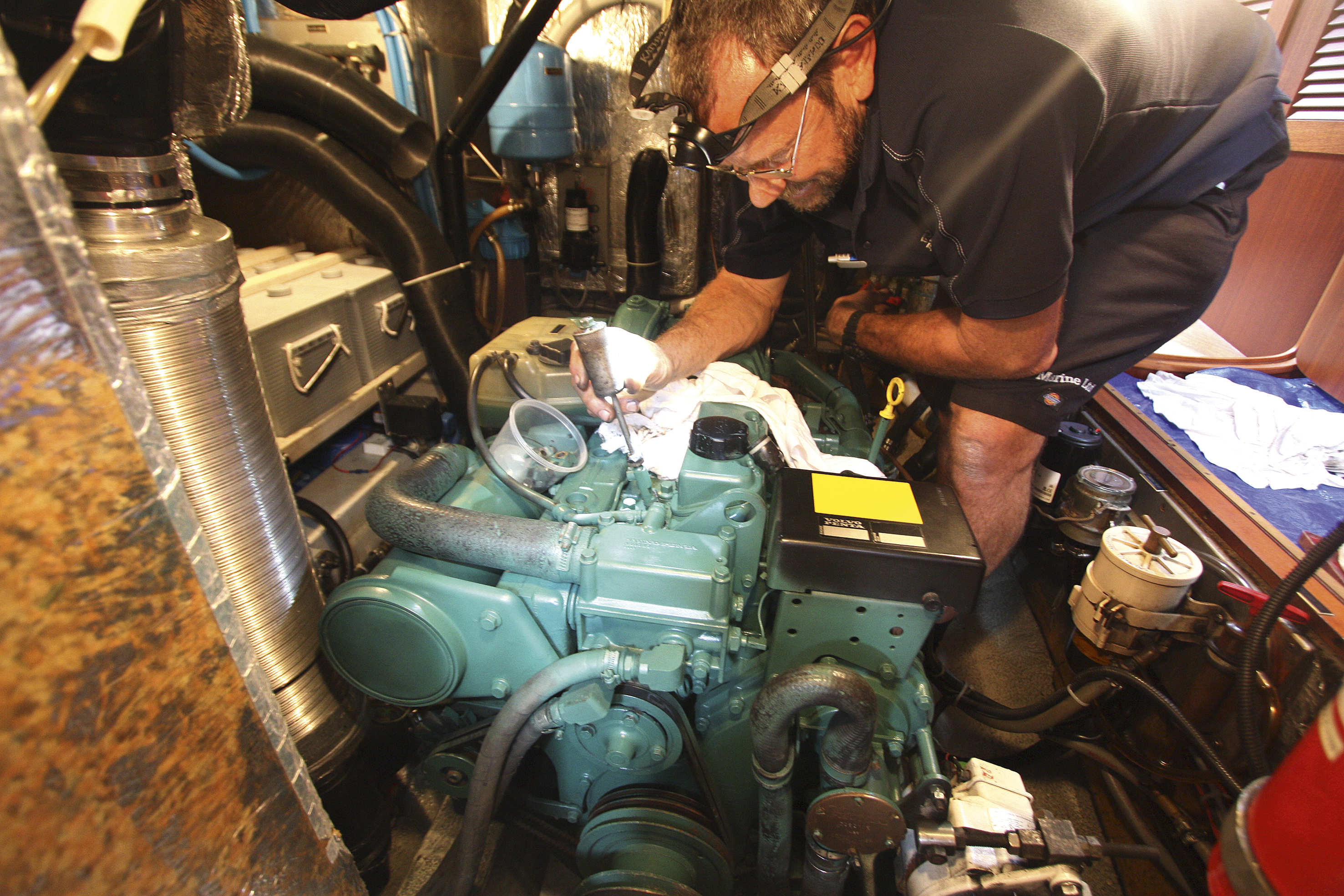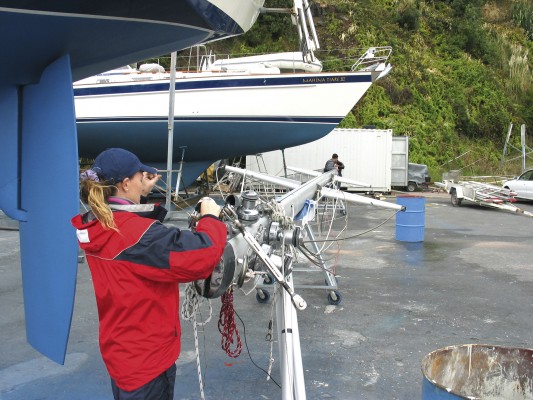John Neal and Amanda Swan Neal take you through a detailed list of how to decommission a yacht when leaving it ashore in a foreign country
A high percentage of cruisers we meet plan to lay up a yacht in a safe place to fly home, often once a year. Since international air travel has never been so cheap, many cruisers find they can cover the cost of flying home with the money they save in buying spare and replacement parts back home.
If you’re leaving your boat for less than three weeks, it may be most convenient to leave it in the water, provided you can find a secure marina berth or mooring. For longer periods of time, it can be cost-effective and attractive to combine dry storage in a secure boatyard with your annual haul-out.
We’ve left our boats, Mahina Tiare I, II and III, on the hard or in the water in Portugal, the Azores, Sweden, Panama, Chile, Hawaii, Canada and New Zealand over the past 35 years and have learned quite a bit.
We believe the following criteria are optimal, but obviously in developing countries not all of these features or services will be available.
First do your homework
As with many things in life and cruising, the first place to start when deciding to leave your boat in a foreign port is to check with other cruisers. Valuable links to boatyards and marinas are posted on www.noonsite.com, and Seven Seas Cruising Association (ssca.org) bulletins frequently publish letters detailing members’ experiences.
If possible, visit the yards and marinas to talk with the operators. Check to see how secure the place is and ask local sailors if there are security problems.
When choosing a boatyard for dry storage, inquire about both your and the boatyard’s insurance policy. Will one of the policies cover damage if your boat is dropped, run into, blown over, or items are stolen? Ideally the yard should be secure, paved and fenced. Ensure the displacement of your boat is not close to the limits of the cradles or travel hoist and that the lift straps and cables are maintained. A steel cradle with adjustable arms is the most secure method of support so be cautious if jacks or 44gal drums with wedges are used.
Ask when the busiest season and holidays occur. Many yards and services are stretched to the max around these times. In our experience, don’t try to get anything achieved in European boatyards during the month of August or in New Zealand or Australia from two weeks before Christmas until a week after the New Year.
If you are leaving the boat for a period of time it may work out well to leave a job list with the yard or associated workmen, so inquire about nearby services, including sail repair, rigging, welding and engine repair. Tradesmen will appreciate working on your boat during quiet times, rather than the job becoming a rush upon your return.
A month before return contact the yard to make sure the jobs are being completed.
Now you’ve successfully chosen a yard to leave your vessel, here is rundown of what requires attention during decommissioning and recommissioning when you get back.
Decommissioning
- Establish points of contact Obtain contact information for the yard or marina and all associated businesses that are working on your boat or equipment. I staple their business cards onto sheets of paper and make multiple photocopies – I leave a copy on the boat and take several copies home. It is generally necessary to contact the businesses and confirm the work is being done within the timeframe agreed.
Consider hiring a local person to check on the boat for you. For this, we often use a business that is working on the boat, eg an electrician or carpenter.
- Wishlist Make a list of marine supplies to purchase and bring back with you.
- Clear decks Clear the decks of removable items: barbecue, jerrycans, anchors, liferaft, sails, outboard, etc. Check your anchor chain and anchors for rust. Re-galvanise as soon as possible, as rusty chain will only continue to rust and erode.
- Engine(s) Change engine and transmission oil and filter. Drain, flush and replace the coolant, taking care not to let the old coolant end up in the ocean. Inspect and replace engine cooling system zinc anodes. Lubricate throttle and shift linkage and cables. Check belts for wear and tension. Clean or replace the air cleaner.
Flag anything that needs attention upon your return or while you’re away. Thoroughly clean the exterior of the engine, wire brushing and painting rusty components. Place new oil-absorbent sheets under the engine to help detect any leaks.
Service outboard motor. Drain and replace lower unit gear oil, check impeller and before turning it off consider spraying fogging preservative down the engine intake.
- Batteries Check battery fluid levels if you don’t have gel or AGM batteries. Fully charge all batteries and then disconnect the master battery switch or remove all battery cables.
- Interior Launder all interior fabrics, as salty, damp or dirty fabric may mildew. Clean galley cupboards and throw out or give away food items that will perish. Go through all lockers and ask yourself: “Is this really necessary to have on board?” Lighten that load instead of raising the boot top.
Wipe all interior surfaces (excluding Plexiglas) with an ammonia-based window cleaner. Leave out roach and ant bait and, if you’re in a tropical location, consider setting off a ‘bug bomb’.
- Liferaft Note the repack date of your liferaft and inquire about the availability of repack facilities. If needed, schedule the repack after your return as it’s best to be present when your raft is inflated to check its condition and supplies.
- Medical Inventory your medical kit, noting drug expiry dates and items that need replenishing. Check local prices; it may be easier and more cost-effective to purchase supplies when returning home.
- Rigging Go up the mast and perform a thorough rig check of all fittings, welds, spreaders, lights, halyards, cotter pins, turnbuckles, sheaves, swages and wires. Clean and grease winches and turnbuckles. You may even consider pulling the mast if it needs repair, rigging replacement or repainting. If repairs require a rigger, book the necessary work before leaving.
- Sails Remove all sails, including furling sails, rinse, dry, inspect and fold them. If repairs are needed, find a sailmaker to book a time for repairs. If you are repairing the sails yourself, check that you have the necessary equipment and supplies.
- Systems Flush the bilge with fresh water after collecting any oil by suspending oil-absorbent material into bilge. Fill propane tanks and disconnect all hoses.
If your refrigeration system is raw water-cooled, flush the system with fresh water. Biocide watermaker. Remove and clean the log impeller.
- Tanks Fill the fuel tanks and add bactericide/stabiliser. Flush holding tanks with water and add vinegar to break down limescale. Lubricate all ball valves or seacocks. Flush freshwater tanks and bleach the tank and hoses.
- Before hauling out Show the lift operator a photo or diagram of your boat’s underbody, marking ideal sling placement locations with masking tape. Request the most secure location in the storage area for your boat. The ideal location will be out of the regular traffic pattern of the travel hoist and will be protected from strong winds from any direction.
- After hauling Have the boat pressure-washed if necessary, or scrub off any growth by hand. Flush the engine for at least 20 minutes by disconnecting the raw water intake from the through-hull fitting and placing the hose in a large bucket with a freshwater hose. You need to adjust the freshwater flow to match the engine intake requirement. In the last few minutes before shutting off the engine pour two to four quarts of coolant (antifreeze) into the bucket and shut off the engine before the last of the fluid is gone. If possible, have the exhaust flow into a bucket below the boat, as antifreeze should be disposed of properly. Dismantle and clean the vacuum/anti-siphon valve if you have one.
- Through-hull fittings At a minimum, turn each handle and spray lubricant where the handle meets the fitting. If your boat is more than ten years old, disassemble, clean and lubricate head, galley and engine intake through-hulls and valves or seacocks. Replace any plumbing showing corrosion.
- Cover the boat A full boat cover protects your boat from sun, dirt and overspray, and keeps the boat cooler inside.
- Record stowage Before leaving, photograph everything for insurance purposes: cradle or marina slip, cover, interior and position of the boat in the yard. Send your insurance company a copy of the photos and advise them of your plans.
See also recommissioning when you return to your yacht
This is an extract from the December 2014 issue of Yachting World






